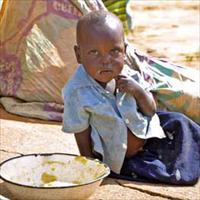AFRICA: Political will needed to check hunger

The lack of political will to invest in agriculture has affected the chances of halving poverty and hunger in Africa by 2015, according to a senior United Nations official.
“Investment in agriculture, more than other sectors, provides four times the returns,” said Kanayo Nwanze, vice-president of the International Fund for Agricultural Development, a UN agency working to end rural poverty.
“There are some countries, like Ghana, which have made tremendous progress in the last seven years, and Uganda; we could have listed Kenya [prior to the current political crisis] which are likely to reach the MDG 1 [Millennium Development Goal to halve poverty and hunger by 2015].”
Three out of four poor people in developing countries – 883 million – lived in rural areas in 2002, according to the World Development Report 2008: Agriculture for Development, the World Bank’s flagship 2007 report on agriculture.
“Most depend on agriculture for their livelihoods, directly or indirectly, so a more dynamic and inclusive agriculture could dramatically reduce rural poverty, helping to meet the Millennium Development Goal on poverty and hunger,” said the Bank’s first analysis of agriculture since 1982, which cited several success stories to illustrate its point that investing in food production can reduce poverty.
Africa has had some success, particularly in Ghana, where agriculture drove the poverty rate down from 51.7 percent in 1991/92 to 39.5 percent in 1998/99, and then to 28.5 percent. Between 2001 and 2005, agriculture grew at 5.7 percent a year, faster than the overall gross domestic product of 5.2 percent.
Since 2001, smallholder-based cocoa production has contributed about 30 percent of agricultural expansion, and “Ghana has also enjoyed strong growth in horticulture (almost 9 percent of total exports in 2006) driven mostly by pineapples,” the World Bank report noted. Uganda adopted economic policies that have resulted in a boom in coffee production.
Asia provides many more examples of effective policy decisions by governments boosting agricultural growth: in Vietnam, land reform, and trade and price liberalisation were implemented; in Bangladesh new technologies have brought rising rural farm and non-farm earnings, with lower prices for rice, the staple food.
“Agriculture was also the key to China’s massive and unprecedented reduction in rural poverty, and to India’s slower but still substantial long-term decline [in the number of rural poor],” the World Bank report pointed out.
Asia is reaping the fruits of the green revolution in the 1970s, while African leaders failed to tap into that momentum, Nwanze said. “Look at India – in the 1960s it was listed as a hopeless case, while in the same period not a single African country was listed as food insecure. Thirty years later India became a food exporter and look at Africa.”
Asian governments provided farmers with credit, price support, and input subsidies. “In sub-Saharan Africa, governments also intervened heavily in markets, but agriculture was taxed more than in other regions – and it still is,” the World Bank report commented.
Although Kenya, Malawi, Zambia and Zimbabwe initiated maize-based revolutions using hybrid seed and fertiliser, the programmes have been difficult to sustain due to high marketing costs, fiscal drain and frequent weather shocks.
Much needs to be done
Besides reducing poverty, Africa needs to invest in agriculture, as demand for food is expected to reach $100 billion by 2015, double the level in 2000.
The report suggested improved price incentives, increasing the quality and quantity of public investment; greater efficiency in product markets; effective access to financial services, with reduced exposure to uninsured risks; enhancing the performance of producer organisations; and promoting innovation through science and technology. Agriculture should be made more sustainable and a provider of environmental services.
A recent joint report by the US-based Michigan State University and the US Agency for International Development (USAID) attempted to take a closer look at the challenges faced by smallholder farmers in Africa and why an “African green revolution” has not happened yet.
“While many farms in Asia were similarly very small at the time of their green revolutions, many of them enjoyed irrigation, higher returns to fertiliser that could be achieved with water control, and more than one cropping season,” said authors Thom Jayne, professor of international development at Michigan State University; David Mather, formerly at Michigan State University; and the World Bank’s Elliot Mghenyi.
“These factors substantially improved Asian land productivity, and partially relieved the severity of the land constraint among small farms. By contrast, the vast majority of African farms are dependent on rain and one crop season per year. “
Nwanze noted that “In Africa, unlike Asia, you have a very patchy farming system – it is not homogenous, like Asia.” The colonial legacy had left much of Africa with severe land inequalities between smallholders, large-scale or state-owned farms, highlighting the need for land reform.
The World Bank report also listed the need for infrastructure development, the lack of which has increased transaction costs and market risks, and investment in fertilisers and irrigation.
About 75 percent of the farmland in Africa is affected by severe mining of soil nutrients, and in sub-Saharan Africa only four percent of crop area is irrigated, a fraction of that in Asia.
A lack of investment in research and development is another obstacle. The main green revolution cereals in Asia were wheat and rice, largely irrigated; sub-Saharan Africa uses a wide range of farming systems and a broad number of staples. Improved varieties for many different crops would be needed to increase productivity.
Technologies developed in other parts of the world were often not directly transferable, and Africa-specific technologies would be required to improve the region’s agricultural productivity.
 Back and Next - Back and Next
Back and Next - Back and Next See Also - See Also
See Also - See Also